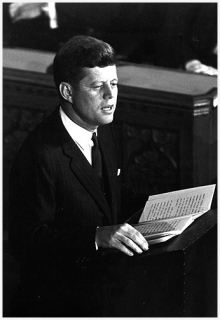Today would be John F. Kennedy’s 100th birthday. Those of a certain age remember him for the hope that he inspired. For many, just the idea that he was in the White House meant that things would get better. His horrible, public murder gashed a generation. JFK’s assassination defined the precise moment between then and now, between what could have been and what was. Kennedy visited Canada four times. Let us consider one that helped change our history and helps define the man.

JFK Addressing Canadian Parliament (CBC photo)
In late 1953, Kennedy was the junior Senator from Massachusetts and forced to consider Canada for the first time. After decades of debate regarding whether the United States and Canada should cooperate in the building the St. Lawrence Seaway, Canada had decided to go it alone. The decision put the thirty-six-year-old Kennedy in a tricky spot. During his Senate campaign, he had listened to Boston longshoremen, businessmen, and lobbyists, and opposed the seaway based on the old worry that it would divert significant traffic from New England ports to the St. Lawrence. To support it would jeopardize his re-election and stymie his presidential aspirations. But he had his staff complete a careful study of the matter and had become convinced that to oppose the seaway would hurt the United States. So, would he vote for himself and his constituency or for his country? Was the book he had written, Profiles in Courage, was just a cute title or a definition of his character?
With pressure building, Kennedy accepted an invitation to speak at the Université de Montréal. It was his first trip to Canada. The senator and his wife of three months, the twenty-four-year-old Jacqueline, arrived on a cold December 4, 1953, at Montreal’s Windsor train station. Only two men met them: an American consulate representative and a Canadian Pacific Railway photographer who quickly snapped two pictures and went home. The glamorous young couple were guests of honour that evening at the annual St. Mary’s Ball, where the city’s who’s who mingled, dined, and raised money for the local hospital.
Before donning his tuxedo, Kennedy addressed the students and faculty of the university’s Literary Society. He said that Canada and the United States were fighting communism together. He explained that 20 percent of American exports went to Canada and that America was Canada’s best customer. Kennedy then explained the difficulty the American Congress was having in coming to a decision regarding the seaway. He detailed the American system of checks and balances and quoted Sir John A. Macdonald, albeit somewhat out of context, who once called the American system a “skilful work.” He quoted eighteenth-century Irish nationalist and conservative political philosopher Edmund Burke. Burke had said in his 1774 “Speech to the Electors of Bristol” that political representatives should be free to vote their conscience. Kennedy’s reference to Burke was a strong hint that he was preparing to do just that.
A few weeks later, on January 14, 1954, Kennedy rose in the Senate chamber and delivered a courageous speech. He began by noting his state’s current and long history of opposition to the seaway. His vote, he said, would rest on the answers to two fundamental questions. The first was whether the seaway would be built regardless of American partnership. “I have studied the Act passed by the Canadian parliament authorizing the construction of the St. Lawrence Seaway by Canada . . . and the official statements of the Canadian government make it clear that Canada will build the Seaway alone and cooperate on the power project with New York, although the door is left open for American participation if we should so decide at this session of Congress.” A solely Canadian project, Kennedy continued, would inflict enormous costs on America, as Canada could dictate tolls, traffic, and admission of foreign shipping.
The second determining question, he argued, was whether the seaway would make America safer. Kennedy explained the degree to which American participation in the project would be part of the continued development of an integrated North American defence strategy. He concluded: “Both nations now need the St. Lawrence Seaway for security as well as for economic reasons.
He concluded, “I urge the Congress promptly to approve our participation in its construction.”
Finally, after decades of opposition, the Senate approved the daring measure. A number of Boston and Massachusetts papers attacked the young senator. Two months later he was warned by a member of Boston’s city council not to march in the city’s large and boisterous annual St. Patrick’s Day parade lest he be abused by dockworkers angry that the seaway would kill their jobs. Kennedy ignored the advice and marched without incident.
Imagine a politician with the political courage to put country over party and principle over popularity, risking re-election for what is right. Imagine a politician who bases decisions on facts rather than gut reactions, polls, or a blind adherence to ideology. Imagine a politician with an ability to speak that is clear, almost poetic, and that demands that we rise to meet him rather than pandering to the least articulate and educated among us. Imagine. And then take a moment today to celebrate John Kennedy’s life and grieve his loss.
If you enjoyed this column, please share it with other. For more on the many ways that Canada was effected by JFK and that we affected him, consider reading Cold Fire: Kennedy’s Northern Front. It is available at bookstores and online through Chapters Indigo and Amazon.
I thoroughly enjoyed this article. I have always had the highest regard and respect for JFK, Kudos.
LikeLike
I too respect his leadership. If my daughter had been born a boy, the name would have been Robert. Thanks for leaving a comment.
LikeLike